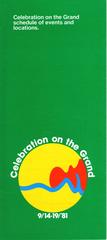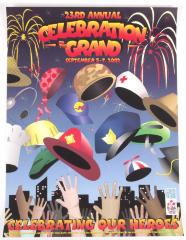Comments and Tags
Be the first to comment on this item!
Souvenirs ➔ Cap, Celebration on the Grand
Identifier:
2015.23.1Description:
A volunteer cap distributed for the annual fireworks and concert event, Celebration on the Grand. This cap is significant because of its association with this important event that was a catalyst for the growth of Grand Rapids. The event started alongside the opening of the Gerald R. Ford Presidential Museum, the Amway Grand Plaza Hotel, and the Grand Rapids Art Museum's move to the Federal Building in 1980 all which were contributing to the resurgence of the downtown. Furthermore, the cap represents the great amount of community support through volunteerism that was pivotal for coordinating the event each year.The Celebration on the Grand event happened annually for over thirty years and ended in 2014 because the organizing group felt their mission of promoting the quality of life in the Grand River Valley had been successfully met.
Date:
circa 1990Materials:
Synthetic FabricDimensions:
12" h 10" w 3" dCurrent Location Status:
In StorageCollection Tier:
Tier 2Source:
Gift of Beryl and Anne LeiberLinks:
http://celebrationonthegrand.org/Related Entities:
Dennis Leiber (donor) Celebration On The Grand (depicts)Celebration on the Grand was a free music festival held in Grand Rapids, Michigan to celebrate the quality of life in the Grand River valley and to act as an unofficial end to the summer for Grand Rapids and included a fireworks display. The event was held annually on the weekend following Labor Day weekend.
The first Celebration on the Grand took place in 1980 as a part of the events that opened the Gerald R. Ford Presidential Museum, the Amway Grand Plaza Hotel, and the Grand Rapids Art Museum's move to the old Federal Building. Funding was provided by corporate sponsorships, private donations and fund raising activities held by COTG volunteers during.
Celebration’s mission was to celebrate the city and encourage others to celebrate the city. For a number of year’s Celebration accomplished this goal through the September Celebration event. Celebration had the opportunity to impact the city more by taking over the 4th of July festivities which fit neatly with its mission. So beginning July 4, 2014, Celebration will be putting on 4th of July festivities, in conjunction with the city, Townsquare and Amway. Celebration on the Grand was normally in September, but with the unique opportunity to put on the 4th of July, the committee jumped at the idea and is proud to be a part of the new improved partnership.
In May 2015 Celebration on the Grand announced the dissolution of the organization. The reason was that for over 30 years they worked to celebrate the people and the spirit of Grand Rapids, and they believed that they had fulfilled that mission. In the last decade the region has flourished and Celebration on the Grand was a catalyst for that growth. They chose to step aside and let other organizations find new ways to keep that momentum going.
Alternate names: Leslie Lynch King Jr.
Gerald R. Ford was born Leslie Lynch King, Jr., in Omaha Nebraska to Dorothy Ayer Gardner and Leslie Lynch King, Sr. In 1913, his mother moved with him to her parents’ home in Grand Rapids, Michigan, and in that same year she gained full custody of her son. In 1916, Dorothy remarried Gerald Rudolff Ford, and in 1935, though not formally adopted, Leslie Jr. legally changed his name to Gerald Rudolff Ford, Jr.
Ford was a member of The Boy Scouts of America, and is the only U.S. President to become an Eagle Scout. He grew up in the Heritage Hill neighborhood of Grand Rapids and attended Grand Rapids South High School. As a star athlete, he was captain of his football team and was selected for the All-City Team. He was later recruited by the University of Michigan’s football team and played for the school in the 1930-1934 seasons. After graduating in the spring of 1935 with a degree in economics, he received offers from the Detroit Lions and the Green Bay Packers. Instead, he took a coaching position at Yale and attended law school there. He graduated in 1941 and was admitted to the Michigan bar association that year.
After his schooling, Ford became an ensign in the U.S. Naval Reserve. He served from 1942-1946. He moved quickly through the ranks and resigned in 1946 as a Lieutenant Commander. He received the Asiatic-Pacific Campaign Medal with nine engagement stars for his service, as well as the American Campaign and World War II Victory Medals. He returned to Grand Rapids after his service. In 1948, Ford married Elizabeth “Betty” Bloomer Warren at Grace Episcopal Church in Grand Rapids. They had four children: Michael, John, Steven, and Susan.
Ford was heavily involved in local Republican politics following his military service. He was elected to the U.S. House of Representatives in 1949 and served there for 25 years, becoming House Minority Leader in 1965. In 1973, after Vice President Agnew resigned, President Nixon appointed Ford as his new Vice President. Less than a year later, in 1974, Nixon also resigned, making Ford President of the United States.
One of Ford’s first acts as president was the controversial pardoning of Nixon, issued in Proclamation 4311. Shortly after, he attempted to pardon Vietnam War “draft dodgers” through an amnesty program that required reaffirmation of allegiance and two years of public service work. Ford’s presidency was plagued with problems, including the end of the Vietnam War and the federal deficit that continued throughout his term. It is because of these problems and Ford’s pardons that he faced two assassination attempts in 1975. It is also likely the result of these issues that caused Ford to lose the 1976 presidential election to Jimmy Carter.
After his presidency, Ford published his autobiography, A Time to Heal, and an anecdotal book, Humor and the Presidency. He maintained a friendship with his successor, Carter, and visited Washington often. He remained active in Republican politics, though being a vocal opponent to conservative colleagues’ anti-LGBT opinions and the war in Iraq.
At the 2000 Republican National Convention, Ford suffered two minor strokes. This triggered a slow decline in the president’s health and on December 26, 2006, Ford died in his home in Rancho Mirage, California, of coronary artery disease. He was 93 years old. His funeral and memorial services were held at the National Cathedral in Washington, D.C., and he was buried at the Gerald R. Ford Presidential Museum in Grand Rapids, Michigan.


